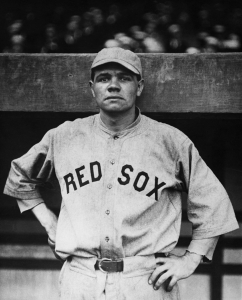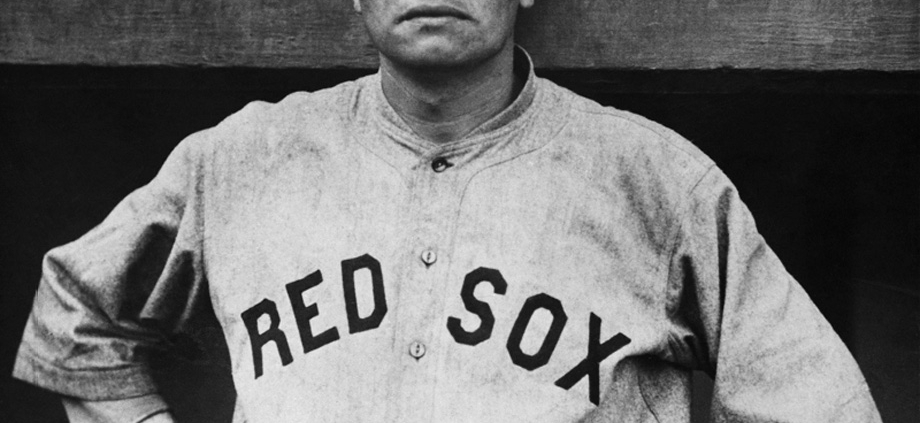October 2, 1914: A sign of so many swats to come: Babe Ruth doubles for first big-league hit
 Even after the game, the 1,500 people who watched a meaningless late-season contest between the Red Sox and the Yankees in the last week of the 1914 American League season would have had no idea that they had witnessed a historic hit by a rookie off a reliever nearing the end of his career.
Even after the game, the 1,500 people who watched a meaningless late-season contest between the Red Sox and the Yankees in the last week of the 1914 American League season would have had no idea that they had witnessed a historic hit by a rookie off a reliever nearing the end of his career.
In the midst of a seven-year run that saw Boston win four championships, the Red Sox had the much stronger of the two clubs led by the superstar center fielder Tris Speaker. The Gray Eagle enjoyed a 22-year career in the AL and played a career-high 158 games in 1914, including this contest.
New York, by contrast, lacked boldface names in both the batting order and pitching rotation. Before the season, Yankee fans might have pointed to the Peerless Leader, Frank Chance, as a reason for optimism, but with 20 games to go in the team’s fourth straight nonwinning campaign, Chance resigned. His replacement, the 23-year-old Roger Peckinpaugh, became the youngest skipper in the history of the majors when he took over as player-manager.
To face Boston, Peckinpaugh tapped Carroll Brown, “the best pitcher that ever promenaded the boardwalk at Atlantic City,”1 thus earning him the splendid sobriquet Boardwalk in place of his more pedestrian birth name. Red Sox player-manager Bill Carrigan countered with rookie southpaw George Ruth, who made his third start for Boston after splitting his first two decisions in July.
The game served as a microcosm of the season for the two teams. The Red Sox took a 2-0 lead in the first thanks to a double by Olaf Henriksen, Speaker’s 18th triple of the year,2 and a single by Dick Hoblitzell, who enjoyed a perfect 4-for-4 day at the plate.
Boston extended its lead in the fourth. Catcher Hick Cady singled, Henriksen walked, Hal Janvrin doubled, Duffy Lewis tripled, and Hoblitzell doubled.
Trailing 6-0, the Yankees finally broke through against Ruth in the sixth thanks to an error by first baseman Janvrin, Peckinpaugh’s single, and a two-run double by the former Boston backstop Les Nunamaker.3 Even here, New York played poor baseball. Down by four runs, catcher Nunamaker should have held at second with a two-bagger rather than trying to take an extra base against the excellent outfield arm of Lewis. Lewis’s peg, one of his 22 assists as a left fielder in 1914, cut down Nunamaker, keeping the Red Sox lead at 6-2.
The Yankees would draw no closer. In the bottom of the same frame, Henriksen and Janvrin both walked, and Roy Hartzell’s error on Speaker’s fly loaded the bases. Lewis’s fly ball scored one run and Hoblitzell’s double plated two more. Brown had given up nine runs (eight earned), the most he had yielded since a September 13, 1912, game against Cleveland. Boston now led 9-2.
King Cole replaced Brown. As Brown had pitched for the pennant-winning 1913 A’s and had won 30 games for the Athletics in 1912-1913, Cole had toiled for the pennant-winning 1910 Cubs and captured 38 games in 1910-1911.
Ruth had gone hitless in his two-plus games for the Red Sox before facing Cole in the seventh. The Babe doubled for the first of his career 2,873 hits and 506 doubles. The “smashing two-ply drive”4 preceded a single by Henriksen and a fly by Janvrin, which enabled Ruth to score the first of his 2,174 career runs and put the Red Sox up 10-2. As of 2018, Ruth had still scored the fourth-most runs in major-league history. In a neat coincidence, Hank Aaron also finished his career with 2,174 runs scored.
Cruising along with a big lead and perhaps tired by his labor on the bases, Ruth eased up. New York scored a run in the eighth on two singles, a walk, and a fly ball. Boston got the run back in the bottom half on a walk, an error, and a single to go up 11-3. In the ninth, the speedy Fritz Maisel smacked an inside-the-park homer, one of three such clouts he would hit as a Yankee.5 Doc Cook walked. Down 11-4, he stole second base and third base. Today, an official scorer would deem these two plays defensive indifference, but in 1914 Cook got credit for two meaningless steals.6 Birdie Cree doubled in Cook to make the final score 11-5 and give Ruth the second of his 94 wins on the mound.
The Cole-Ruth confrontation that transformed the game from meaningless to memorable highlighted two hurlers who had more similarities than the casual baseball fan might assume. Superficially, both pitchers with four-letter last names more commonly went by four-letter nicknames rather than their given names (Leonard for Cole and George for Ruth). Both pitched for the Yankees under Hall of Fame managers (Cole for Chance,7 and Ruth for Miller Huggins and Joe McCarthy). Both won 20 games as pitchers with league-leading ERAs under 2 for pennant winners (Cole went 20-4 with a 1.80 ERA for the 1910 Cubs; Ruth went 23-12 with a 1.75 ERA for the 1916 Red Sox).
Both died young, Cole at the age of 29, and Ruth at 53. Deadball Era baseball fans could hardly have imagined that years after his hit off Cole, the Boston rookie hurler Ruth would go on to become the Sultan of Swat for New York.
Ruth hit a then-record 54 homers in his first season with the Yankees in 1920, playing regularly alongside two of the more prominent players in this 1914 game. Duffy Lewis had preceded Ruth by one year, going from Boston to New York in time for the 1919 season.8 Alone among his 1914 New York teammates, Peckinpaugh remained with the Yankees and still held down the shortstop position through 1921.
In the first postseason game in franchise history, that year, Peckinpaugh played shortstop and batted second, one slot in front of Ruth, who played left field. The Yankees have the most storied World Series record of any team, a history that began on October 5, 1921, against the New York Giants with a leadoff single by Elmer Miller, a sacrifice by Peckinpaugh, and an RBI single by Ruth that gave the Yanks a 1-0 lead in a game that would end 3-0. Although the Giants would go on to win the 1921 World Series, the echoes of a double Ruth hit in 1914 would resound for generations of Bronx Bombers.
Notes
1 “Athletics Helpless before Caldwell,” New York Times, April 18, 1914.
2 Speaker finished third in the AL with 18 triples behind his teammate Larry Gardner, who hit 19, and the remarkable Sam Crawford, who, at the age of 34, hit a career-best 26 triples. Crawford holds the all-time record with 309 career triples.
3 Nunamaker averaged fewer than 10 extra-base hits per season, but had at least three of them against Ruth. “On April 25, [1916,] he clobbered Red Sox ace Babe Ruth for a double, a triple, and two singles…” Tony Bunting, “Les Nunamaker,” sabr.org/bioproj/person/790ea82d (accessed May 23, 2018).
4 T.H. Murnane, “Highlanders Out of Running from Start,” Boston Globe, October 3, 1914: 7. A correspondent for a New York paper made a simple reference to “Ruth’s double” rather than describing the hit in any detail. “Red Sox Pound Yankee Pitchers,” New York Times, October 3, 1914.
5 Mitchell S. Soivenski, New York Yankees Home Runs (Jefferson, North Carolina: McFarland & Company, Inc., 2013), 283. Maisel also got his 69th stolen base of the season in this game. His 1914 total of 74 stolen bases remained the Yankee record until Rickey Henderson stole 80 in 1985. Henderson subsequently stole 87 bases for the Yankees in 1986 and 93 in 1988. Maisel’s 1914 total remained fourth best in franchise history at the end of the 2018 season.
6 Cook needed the scoring generosity. He finished the 1914 season with 26 steals, which appears impressive absent the context that he was caught stealing 32 times. Both Cook and Eddie Murphy of the A’s finished with the league-worst mark in this category, but Murphy at least had 10 more stolen bases than Cook did.
7 “Frank Chance always considered Cole a great pitcher, when he was in condition, and when the Peerless Leader came … to manage the Yankees one of his first official acts was to bring Cole back from the minors.” “Pitcher ‘King’ Cole Dead,” New York Times, January 7, 1916.
8 “A story Lewis loved telling in later years was about the time he pinch-hit for Babe Ruth. On July 11, 1914, Ruth made his major-league debut, hurling a 4-3 victory over the Cleveland Indians. Lewis hit for Ruth in the seventh inning and singled, helping to give his young teammate the victory.” Mark Armour, “Duffy Lewis,” sabr.org/bioproj/person/5f9f3a44 (accessed May 23, 2018).
Additional Stats
Boston Red Sox 11
New York Yankees 5
Fenway Park
Boston, MA
Box Score + PBP:
Corrections? Additions?
If you can help us improve this game story, contact us.


